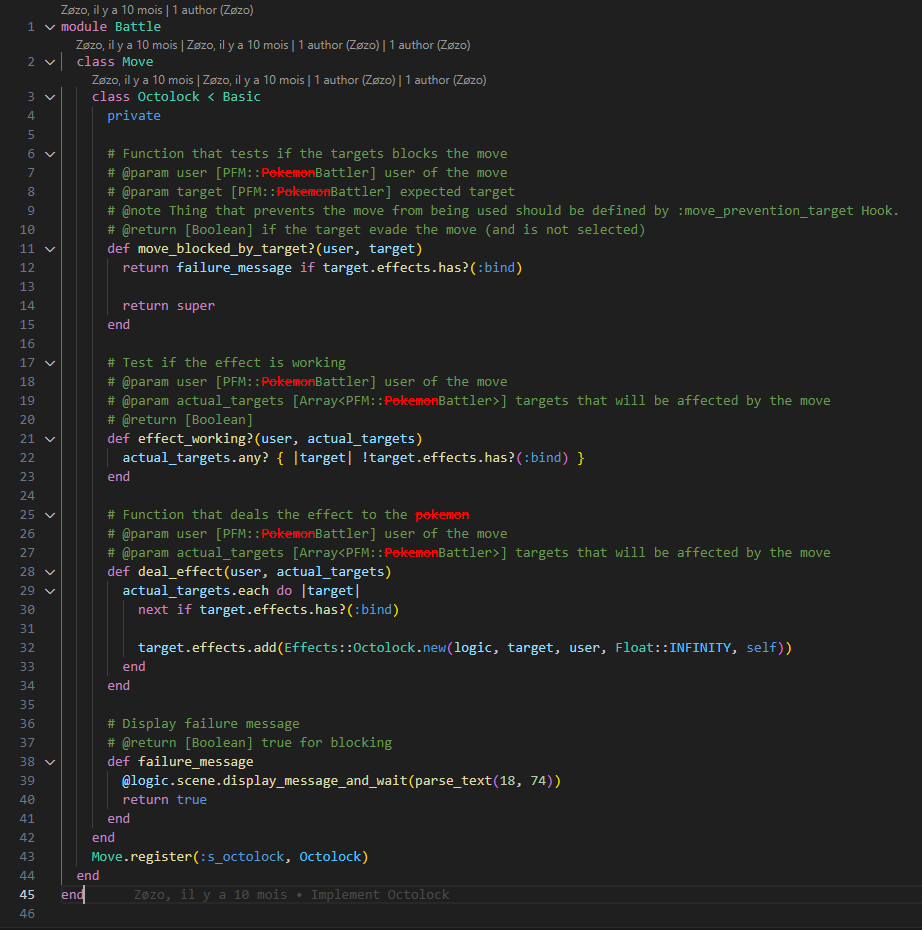How to block a move?
What are the ways to block a move?
Blocking the move is a process that depends on the characteristics of the target. If there is a reason why the target causes a move block, the functions related to blocking should return true instead of false and provide a message indicating the reason for the block before returning true.
From the move code itself
Some moves may fail due to their mechanics. For example, using Bind on a target that is already under the effect of Bind should fail. To handle this, there is a method in moves called move_blocked_by_target?, which should return true if the target is already under the effect of Bind.
Example with "Octolock"

Note: To learn more about move_blocked_by_target?, please refer to the Understanding the move_blocked_by_target? function section at the end of the article.
From the code of an effect
Effects provide a function that returns true when move_blocked_by_target? is invoked. This method is called on_move_prevention_target. Its functionality is similar to move_blocked_by_target?; if it returns true, the move will be dodged. This is useful for creating effects (abilities, items, weather, terrains, etc.) that grant a Pokemon immunity to certain moves.
Example with the Ability "Good as Gold"

Understanding the function move_blocked_by_target?

What particularly interests us in this function:
exec_hooks(Move, :move_prevention_target, binding)
exec_hooks: This method is called to execute a series of Hooks. Hooks are functions or procedures triggered by specific events or conditions in the program. They allow modifications to the standard behavior of a function or the addition of extra functionalities without altering the original function's code.
Move: The first argument specifies the context or domain of the Hooks to execute. Here, Move indicates that the Hooks are related to Pokemon moves, representing the class that groups Hooks associated with moves.
:move_prevention_target: The second argument is a symbol that identifies the specific Hooks to execute. In this case, :move_prevention_target refers to Hooks that determine whether a Pokemon can perform a specific move. These Hooks may include checks for conditions such as status effects, terrain, weather, or other factors that might block the move.
binding: The third argument, binding, encapsulates the execution context of the code in Ruby, including local variables, methods, and the value of self. Passing binding to exec_hooks enables the Hooks to access and modify the context in which exec_hooks was called, allowing them to interact seamlessly with the original code of the move_blocked_by_target? method.
Understanding the procedure of the function move_blocked_by_target?
Hook Call
When exec_hooks(Move, :move_prevention_target, binding) is executed, it identifies and runs all Hooks associated with the event or condition :move_prevention_target in the context of moves (Move). These Hooks are triggered to evaluate whether the move can be performed under the current conditions.
Handling the Value Returned by the Hook
If none of the executed Hooks raises a Hooks::ForceReturn exception, the move_blocked_by_target? function proceeds with its normal execution and eventually reaches the return false statement at the end. This indicates that the move is not blocked.
However, if a Hook determines that the move should not be executed and returns true—either directly or by raising an exception like Hooks::ForceReturn with e.data set to true—the execution of move_blocked_by_target? is interrupted. In this case, the function immediately returns true to its caller.
Consequences of Returning true
Returning true signifies that the move has been prevented due to specific conditions. This could result from various in-game factors such as terrain effects, abilities, status effects, or other mechanisms.
The calling function or method that invoked move_blocked_by_target? must then handle this true return value to determine the next steps. For example, it might display a message to the player explaining why the move was blocked or apply additional effects resulting from the prevention.